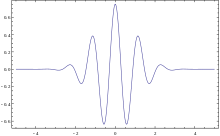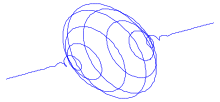Morlet wavelet


In mathematics, the Morlet wavelet (or Gabor wavelet)[1] is a wavelet composed of a complex exponential (carrier) multiplied by a Gaussian window (envelope). This wavelet is closely related to human perception, both hearing[2] and vision.[3]
In 1946, physicist Dennis Gabor, applying ideas from quantum physics, introduced the use of Gaussian-windowed sinusoids for time-frequency decomposition, which he referred to as atoms, and which provide the best trade-off between spatial and frequency resolution.[1] These are used in the Gabor transform, a type of short-time Fourier transform.[2] In 1984, Jean Morlet introduced Gabor's work to the seismology community and, with Goupillaud and Grossmann, modified it to keep the same wavelet shape over equal octave intervals, resulting in the first formalization of the continuous wavelet transform.[4] (See also Wavelet history)
The wavelet is defined as a constant  subtracted from a plane wave and then localised by a Gaussian window:[5]
subtracted from a plane wave and then localised by a Gaussian window:[5]
where  is defined by
the admissibility criterion and the normalisation constant
is defined by
the admissibility criterion and the normalisation constant  is:
is:
The Fourier transform of the Morlet wavelet is:
The "central frequency"  is the position of the global maximum of
is the position of the global maximum of  which, in this case, is given by the solution of the equation:
which, in this case, is given by the solution of the equation:
The parameter  in the Morlet wavelet allows trade between
time and frequency resolutions. Conventionally, the restriction
in the Morlet wavelet allows trade between
time and frequency resolutions. Conventionally, the restriction  is used to avoid problems with the Morlet wavelet at low
is used to avoid problems with the Morlet wavelet at low  (high temporal resolution).
(high temporal resolution).
For signals containing only slowly varying frequency and amplitude
modulations (audio, for example) it is not necessary to use small
values of  . In this case,
. In this case,  becomes very small (e.g.
becomes very small (e.g.  ) and is, therefore, often neglected. Under the restriction
) and is, therefore, often neglected. Under the restriction  , the frequency of the Morlet wavelet is conventionally taken to be
, the frequency of the Morlet wavelet is conventionally taken to be  .
.
The wavelet exists as a complex version or a purely real-valued version. Some distinguish between the "real Morlet" vs the "complex Morlet".[6] Others consider the complex version to be the "Gabor wavelet", while the real-valued version is the "Morlet wavelet".[7][8]
See also
References
- ↑ 1.0 1.1 A Real-Time Gabor Primal Sketch for Visual Attention "The Gabor kernel satisfies the admissibility condition for wavelets, thus being suited for multi-resolution analysis. Apart from a scale factor, it is also known as the Morlet Wavelet."
- ↑ 2.0 2.1 Time-Frequency Dictionaries, Mallat
- ↑ J. G. Daugman. Uncertainty relation for resolution in space, spatial frequency, and orientation optimized by two-dimensional visual cortical filters. Journal of the Optical Society of America A, 2(7):1160–1169, July 1985.
- ↑ http://rocksolidimages.com/pdf/gabor.pdf
- ↑ John Ashmead (2012). "Morlet Wavelets in Quantum Mechanics". Quanta 1 (1): 58–70. doi:10.12743/quanta.v1i1.5.
- ↑ Matlab Wavelet Families - "Morlet Wavelet: morl" and "Complex Morlet Wavelets: cmor"
- ↑ Mathematica documentation: GaborWavelet
- ↑ Mathematica documentation: MorletWavelet
- P. Goupillaud, A. Grossman, and J. Morlet. Cycle-Octave and Related Transforms in Seismic Signal Analysis. Geoexploration, 23:85-102, 1984
- N. Delprat, B. Escudié, P. Guillemain, R. Kronland-Martinet, P. Tchamitchian, and B. Torrésani. Asymptotic wavelet and Gabor analysis: extraction of instantaneous frequencies. IEEE Trans. Inf. Th., 38:644-664, 1992



